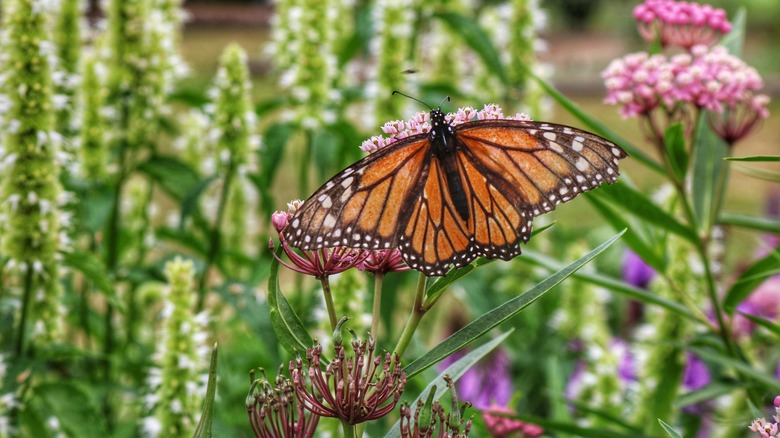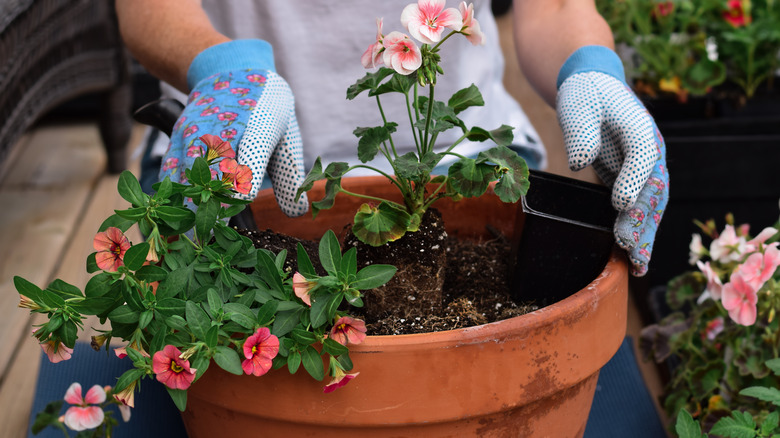DIY A Pollinator Pot To Attract Hummingbirds & Butterflies To Your Outdoor Space
We've all heard our American pollinators need help. And you want to do your bit. However, your teeny balcony or postage stamp-sized yard with no space for an abundant pollinator plant-filled plot has you scratching your head, wondering how to bring more pollinators into your yard and garden. We've got you covered with this easy-peasy DIY! The process is pretty much the same as regular container gardening; the choices you need to make, from soil to the planter, vary little. The main difference lies in the plants you choose. Instead of selecting greenery for its aesthetics, scent, or trendiness, you'll focus on flowering shrubs with maximum pollinator attraction potential — that is, blooms that hummingbirds, butterflies, and other nectar and pollen-loving critters love to dine on.
Even the teeniest pot of flowers can do wonders for the health of our local ecosystems, especially in dense urban areas. Trust us, this wee pot of nectar and pollen is worth it to famished wildlife. Of course, where you live matters, too. Different states, or even parts of states, host varied populations of pollinating insects and birds. Enter your zip code into the plant finder on Pollinator Partnership to determine what plants will best feed the beasties in your area. There's also the issue of which plants thrive in your particular USDA Hardiness Zone. Don't know what your zone is? Visit the Zone Map to find that number before you head to your local nursery.
Picking the right pollinator plants for your pot
Most plants in the lamiaceae (mints and balms like salvias and agastaches), asteraceae (daisy), and umbelliferae (carrot) families are all easy to find and grow options. Getting free milkweed seeds for a stunning butterfly garden is also a good place to start! Milkweed grows great in containers. Choose native plants over cultivars or introduced species whenever possible. Overwhelmed by choice? Start with a wildflower seed mix like the Low-Grow mix from American Meadows — get a quarter-pound of seeds for under $25.
If you plan to put more than one plant in a large pot (recommended), then make sure the plants you choose occupy contrasting niches or come to life at different times of the year — spring bulbs with summer-blooming perennials; winter dormant plants with evergreens; or the classic "thriller-spiller-filler" combination. Check, too, how much sunshine the plants prefer. Most flowering or fruiting plants need lots of sun to achieve maximum bloom potential; some do better in partial or even full shade. Don't make the mistake of planting sun-loving and shade-loving plants together. You can also create seasonal pots, changing up the annuals you plant each year to see what works best for the nectar and pollen-seeking visitors to your area over time. A final option is to plant out multiple pots and group them together for visual effect, the flexibility of placement and planting, and, quite simply, far greater pollinator attraction potential.
Putting your pollinator plant pot together
Look for glazed ceramic or resin planters in any shape that are at least 16 inches deep and have drainage holes. Down to 12 inches may work for shallow-rooted bloomers. If you have a patio or large balcony to work with, mix and match pots of different dimensions, giving you space for lots more plants. You can attract pollinators even in the smallest of spaces: think a single window box or vertical garden. Use your regular container planting medium if you have some or buy a standard container mix like Gertens — under $18 for 40 quarts — and a slow-release fertilizer like Osmocote Plus — about $35 from Walmart. If you're a total newbie, buy a DIY pollinator pot kit with everything you need: seeds, pot, soil, and amendments. Planted Places sells a kit for under $39.99, or you can spend under $50 on a Pollinator Garden in a Box from Plant Seads. Then, pot up your plants as you would a regular container and place it in its designated spot.
Avoid using any pesticides, organic or chemical, on your pollinator pot; you don't want to kill the very insects you're trying to attract! If you live in a cold spot, mulch your containers or bring them inside in winter to protect the plants from frost or snow damage. Looking to up your pollinator pot game? Elevate your DIY container garden with this handy project and never bend down to weed or water again!

